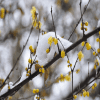Unveiling the aesthetic secrets: exploring connections between genetic makeup, chemical, and environmental factors for enhancing/improving the color and fragrance/aroma of Chimonanthus praecox
- PMID: 38650650
- PMCID: PMC11034496
- DOI: 10.7717/peerj.17238
Unveiling the aesthetic secrets: exploring connections between genetic makeup, chemical, and environmental factors for enhancing/improving the color and fragrance/aroma of Chimonanthus praecox
Abstract
Floral color and scent profiles vary across species, geographical locations, and developmental stages. The exclusive floral color and fragrance of Chimonanthus praecox is contributed by a range of endogenous chemicals that distinguish it from other flowers and present amazing ornamental value. This comprehensive review explores the intricate interplay of environmental factors, chemicals and genes shaping the flower color and fragrance of Chimonanthus praecox. Genetic and physiological factors control morpho-anatomical attributes as well as pigment synthesis, while environmental factors such as temperature, light intensity, and soil composition influence flower characteristics. Specific genes control pigment synthesis, and environmental factors such as temperature, light intensity, and soil composition influence flower characteristics. Physiological processes including plant hormone contribute to flower color and fragrance. Hormones, notably ethylene, exert a profound influence on varioustraits. Pigment investigations have spotlighted specific flavonoids, including kaempferol 3-O-rutinoside, quercetin, and rutin. Red tepals exhibit unique composition with cyanidin-3-O-rutinoside and cyanidin-3-O-glucoside being distinctive components. Elucidating the molecular basis of tepal color variation, particularly in red and yellow varieties, involves the identification of crucial regulatory genes. In conclusion, this review unravels the mysteries of Chimonanthus praecox, providing a holistic understanding of its flower color and fragrance for landscape applications. This comprehensive review uniquely explores the genetic intricacies, chemical and environmental influences that govern the mesmerizing flower color and fragrance of Chimonanthus praecox, providing valuable insights for its landscape applications. This review article is designed for a diverse audience, including plant geneticists, horticulturists, environmental scientists, urban planners, and students, offering understandings into the genetic intricacies, ecological significance, and practical applications of Chimonanthus praecox across various disciplines. Its appeal extends to professionals and enthusiasts interested in plant biology, conservation, and industries dependent on unique floral characteristics.
Keywords: Chimonanthus praecox; Flower color; Flower fragrance; Genetic regulation; Landscape design.
©2024 Zhao et al.
Conflict of interest statement
The authors declare there are no competing interests.
Figures


Similar articles
-
Integrated Multiomics Analysis Sheds Light on the Mechanisms of Color and Fragrance Biosynthesis in Wintersweet Flowers.Int J Mol Sci. 2025 Feb 16;26(4):1684. doi: 10.3390/ijms26041684. Int J Mol Sci. 2025. PMID: 40004148 Free PMC article.
-
Comprehensive analysis of wintersweet flower reveals key structural genes involved in flavonoid biosynthetic pathway.Gene. 2018 Nov 15;676:279-289. doi: 10.1016/j.gene.2018.08.050. Epub 2018 Aug 16. Gene. 2018. PMID: 30121381
-
TPS genes expression pattern and terpenoids content in the leaves and flowers of Chimonanthus praecox and C. salicifolius.Sci Rep. 2025 Jun 3;15(1):19474. doi: 10.1038/s41598-025-04806-7. Sci Rep. 2025. PMID: 40461601 Free PMC article.
-
The Scent of Lily Flowers: Advances in the Identification, Biosynthesis, and Regulation of Fragrance Components.Int J Mol Sci. 2025 Jan 8;26(2):468. doi: 10.3390/ijms26020468. Int J Mol Sci. 2025. PMID: 39859184 Free PMC article. Review.
-
Biotechnological Advancements for Improving Floral Attributes in Ornamental Plants.Front Plant Sci. 2017 Apr 20;8:530. doi: 10.3389/fpls.2017.00530. eCollection 2017. Front Plant Sci. 2017. PMID: 28473834 Free PMC article. Review.
Cited by
-
Identification of Characteristic Flavor Compounds and Quality Evaluation of Butyriboletus roseoflavus from Different Regions in Yunnan.Foods. 2025 May 9;14(10):1676. doi: 10.3390/foods14101676. Foods. 2025. PMID: 40428457 Free PMC article.
-
Integrated Multiomics Analysis Sheds Light on the Mechanisms of Color and Fragrance Biosynthesis in Wintersweet Flowers.Int J Mol Sci. 2025 Feb 16;26(4):1684. doi: 10.3390/ijms26041684. Int J Mol Sci. 2025. PMID: 40004148 Free PMC article.
References
-
- Arimura G, Ozawa R, Kugimiya S, Takabayashi J, Bohlmann J. Herbivore-induced defense response in a model legume. Two-spotted spider mites induce emission of (E)-β-ocimene and transcript accumulation of (E)-β-ocimene synthase in Lotus japonicus. Plant Physiology. 2004;135(4):1976–1983. doi: 10.1104/pp.104.042929. - DOI - PMC - PubMed
-
- Azuma H, Totota M, Asakawa Y. Floral scent chemistry and stamen movement of Chimonanthus praecox (L.) link (Calycanthaceae) Acta Phytotaxonomica et Geobotanica. 2005;56(2):197–201. doi: 10.18942/apg.KJ00004623244. - DOI
-
- Bartolini S, Piccolo ELo, Remorini D. Different summer and autumn water deficit affect the floral differentiation and flower bud growth in apricot (Prunus armeniaca L.) Agronomy. 2020;10:914. doi: 10.3390/agronomy10060914. - DOI
-
- Bell N, Stoven H, Melathopoulos A. Trees and shrubs for fall and winter bloom. Oregon State University, Extension Service, USA; 2020.
Publication types
MeSH terms
LinkOut - more resources
Full Text Sources

